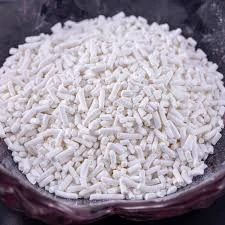
emulsifier 471
Understanding Emulsifier E471 A Comprehensive Overview
Emulsifier E471, also known as mono- and diglycerides of fatty acids, is a widely used food additive recognized for its versatility in various culinary and industrial applications. This substance plays a pivotal role in food technology, particularly in stabilizing emulsions, which are mixtures of two immiscible liquids, such as oil and water. In this article, we will delve into the functions, sources, applications, and safety of E471.
What is E471?
E471 is a compound derived primarily from glycerol and fatty acids. It is classified as an emulsifying agent, meaning it helps blend ingredients that usually do not mix well, such as fat and water. This property is essential in the food industry, where maintaining a consistent texture and preventing separation is crucial. E471 is accepted in various food products, ranging from baked goods to margarine and sauces.
Sources of E471
The fatty acids used to produce E471 can be derived from both plant and animal sources. Common vegetable oils such as soybean, palm, and canola are often used, but it can also come from animal fats. The classification of E471 as vegan or non-vegan therefore depends on its source. This raises an important consideration for consumers with dietary preferences or restrictions.
Applications in Food Industry
Emulsifier E471 is prevalent in a variety of food items due to its multifunctional properties. Here are some key applications
1. Baked Goods E471 is used in bread, cake mixes, and other baked products to improve texture, extend shelf life, and maintain moisture. 2. Dairy Products In ice creams and creams, E471 helps achieve a smooth and creamy consistency while preventing the formation of ice crystals.
4. Confectionery E471 is often found in chocolates and sugar candies to facilitate smoother textures and improve processing.
emulsifier 471

5. Processed Foods It is a common ingredient in processed and convenience foods, enhancing mouthfeel and stability.
Benefits of E471
The use of E471 in food products provides several advantages
- Texture Improvement It significantly enhances the mouthfeel and texture of food items. - Stabilization E471 helps maintain the stability of emulsions, preventing separation in products like sauces and dressings.
- Shelf Life Extension By stabilizing ingredients, E471 can help extend the shelf life of several food products, reducing waste.
- Cost-Effectiveness E471 is relatively inexpensive to produce, making it an economical choice for manufacturers.
Safety and Regulatory Status
E471 is generally recognized as safe (GRAS) by food safety authorities in several countries, including the United States and the European Union. While it is deemed safe for consumption, some individuals with allergies to specific fats or dietary restrictions, particularly vegans or vegetarians, may want to be cautious about its use due to its potential animal origin.
Although adverse effects from E471 consumption are rare, some individuals may experience digestive discomfort if consumed in large quantities. Therefore, as with any additive, moderation is key.
Conclusion
Emulsifier E471 is an integral component in the modern food industry, serving multiple roles that significantly improve product quality and consistency. While it is generally deemed safe and effective, consumers should be mindful of its origins, especially those following specific dietary guidelines. Understanding additives like E471 enhances consumer knowledge, allowing for informed choices in a diverse food marketplace. As food technology continues to evolve, E471 will likely remain a staple in creating stable, appealing, and delicious food products worldwide.
-
Aluminum Hydroxide: Quality Gels & Dried Gel AntacidNewsAug.31,2025
-
Buy High-Quality Trichloroisocyanuric Acid for Sale | TCCA 90% SupplierNewsAug.30,2025
-
Pure Sodium Dichloroisocyanurate Dihydrate | Powerful DisinfectantNewsAug.29,2025
-
Industrial Chemicals: Quality & Purity for Every IndustryNewsAug.28,2025
-
Nitrile Rubber Honoring Strict Production StandardsNewsAug.22,2025
-
Aspartame Ingredients Honoring Food Safety ValuesNewsAug.22,2025
-
Fertilizer for Balanced Plant NutritionNewsAug.22,2025
Hebei Tenger Chemical Technology Co., Ltd. focuses on the chemical industry and is committed to the export service of chemical raw materials.
-

view more DiethanolisopropanolamineIn the ever-growing field of chemical solutions, diethanolisopropanolamine (DEIPA) stands out as a versatile and important compound. Due to its unique chemical structure and properties, DEIPA is of interest to various industries including construction, personal care, and agriculture. -

view more TriisopropanolamineTriisopropanolamine (TIPA) alkanol amine substance, is a kind of alcohol amine compound with amino and alcohol hydroxyl, and because of its molecules contains both amino and hydroxyl. -

view more Tetramethyl Thiuram DisulfideTetramethyl thiuram disulfide, also known as TMTD, is a white to light-yellow powder with a distinct sulfur-like odor. It is soluble in organic solvents such as benzene, acetone, and ethyl acetate, making it highly versatile for use in different formulations. TMTD is known for its excellent vulcanization acceleration properties, which makes it a key ingredient in the production of rubber products. Additionally, it acts as an effective fungicide and bactericide, making it valuable in agricultural applications. Its high purity and stability ensure consistent performance, making it a preferred choice for manufacturers across various industries.





